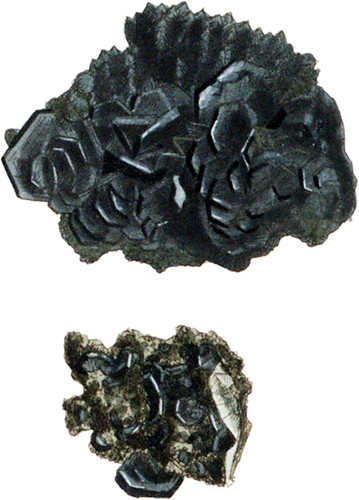 Enlarge
Enlarge
Exotic Mineralogy
Brittle Sulphuret of Silver
- Syn.
- Sprödglaserz. Werner.
- Antimoniated Silver ore. Kirwan 2. 118.
- Argent Antimonié sulfuré noir. Haüy Tab. 76.
- Argent sulfuré fragile. Bournon’s Cat. 207.
- Brittle Sulphuretted Silver. Aikin 78.
- Roschgewachs of the Hungarians.
The oldest Mineralogists have recognized this species of Silver ore, but it has of late years become so rare, that it appears to have been unknown to Haüy when he wrote his Treatise, and but imperfectly known when he published his Tables; this circumstance, as Bournon well observed, has caused him and other French Mineralogists to consider it as a variety of the dark red silver ore, which sometimes assumes a metallic lustre, and in a state of decomposition, may produce a black powdery mass, (the Argent noir of Haüy’s Systeme 111,416).
The analyses of the metallic sulphurets have in general been performed under circumstances that have rendered them questionable, especially the older ones, and even now it appears to be a matter of dispute, whether metals can unite to sulphur and oxygen at the same time; however, the metallic lustre of the present mineral exempts it from the suspicion of containing oxygen, at the same time that it distinguishes it from the red Antimonial Sulphuret of Silver, which probably contains an additional portion, of Sulphur, combined, The tabular form of the crystals of brittle Sulphuret and their being transversely striated upon their lateral planes, not longitudinally, joined to their perfect opacity and less degree of brittleness, will at once point it out to a Mineralogist. Bournon states the hexahedral prism to be the primitive form, and describes three modifications upon the terminal edges; the lower specimen in the plate contains one of these. In the red Silver the terminal faces of the crystals are generally in threes resulting from decrements upon the rhomb similar to those of Carbonate of Lime, in the brittle Silver ore they are in sixes, like those of the Phosphate of Lime; the former is also generally prismatic; the latter tabular: these observations tend to prove that they do not result from an alteration of the red Silver, as some have supposed. What the quadrilateral tables or rhomboids are, that have been mentioned as belonging to this substance I do not know, but I suspect they belong to the flexible sulphuret which often accompanies it. Sulphuret of Iron, red Silver ore, native Arsenic, Galæna, &c. often occur with it in a matrix of Quartz and Carbonate of Lime. Klaproth’s analysis is as follows:
| Silver | 66.50 |
| Sulphur | 12.00 |
| Antimony | 10.00 |
| Iron | 5.00 |
| Copper and Arsenic | 0.50 |
| Earthy substances | 1.00 |
| 95.00 |
Mr. Henry Heuland has assisted me with specimens for figures and examination ; they are from the Neuen Morgenstern mine (new Morning Star mine) at Freyberg, in Saxony. The crystals in the larger one, of an uncommon size, are planted among arborescent flexible Sulphuret, with Iron pyrites; the other has only the pyrites.

